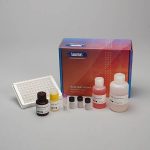
Salimetrics Assay #1-3202
The Salimetrics Salivary Estrone (E1) Enzyme Immunoassay Kit was specifically designed to standardize the detection of estrone in saliva samples for research and biomedical laboratories. Using a small sample volume, this assay kit has an extended range that spans the expected estrone levels found in human saliva. The average inter- and intra-assay precision coefficients of variation are low with no deleterious matrix effects often found in saliva which are characterized through dilution- and spike-recovery validation procedures. This estrone assay kit has also been formatted to minimize cross reactivity for related steroids. Read More...A major portion of estrone [3-hydroxy-1,3,5(10)-estratrien-17-one: E1] is produced from androstenedione in prepubertal children, men, and postmenopausal women and of the three major estrogens, estrone is predominant after menopause in women. For this reason, research concerning Estrone is often focused on pregnancy, reproduction, and menopause. However, estrogens affect a diverse group of biological processes such as arterial vasodilation, bone density, cognitive function, and neuroprotection. Estrogens are also studied in regard to coronary artery disease, immunocompetence, cancer susceptibility and polycystic ovarian syndrome. Estrone is also a primary component of many pharmaceutical preparations.
Technical Summary
| Assay Protocol |
|---|
| Rev. 05.30.25
|
| Specifications | |
|---|---|
| Catalog#: | 1-3202 |
| Regulatory Status: | RUO |
| Format: | 96-well plate |
| Assay Time: | ~ 4 hrs |
| Sample Volume/Test: | 100 µL |
| Sensitivity: | 3.04 pg/mL |
| Assay Range: | 3.1 pg/mL - 300 pg/mL |
| Storage Requirements: | 2-8°C |
| Tests Per Kit | |
|---|---|
| Singlet: | 78 |
| Duplicate: | 39 |
| Target Analyte |
|---|
| Technical Documentation |
|---|
Salivary Estrone Assay Kit Overview
Intended Use
The Salimetrics Estrone Enzyme Immunoassay Kit is a competitive immunoassay specifically designed and validated for the quantitative measurement of salivary Estrone. It is not intended for diagnostic use. It is intended only for research use in humans and some animals. Salimetrics has not validated this kit for serum or plasma samples.
Introduction
Estrone [3-hydroxy-1,3,5(10)-estratrien-17-one; E1] is a naturally occurring steroidal hormone. A major portion of Estrone is produced from androstenedione in prepubertal children, men, and postmenopausal women. Circulating Estrone levels are relatively high at birth in both males and females, decrease postnatally, and increase during puberty. Of the three major estrogens, Estrone is predominant after menopause in women. Estrone is primarily secreted by the ovaries in premenopausal women, peaking in the preovulatory phase with a smaller secondary increase during the luteal phase. Estrone is a primary component of many pharmaceutical preparations. Research concerning Estrone is often focused on pregnancy, reproduction, and menopause. However, estrogens affect a diverse group of biological processes such as arterial vasodilation, bone density, cognitive function, and neuroprotection. Estrogens are also studied in regard to coronary artery disease, immunocompetence, cancer susceptibility and polycystic ovarian syndrome.
Salivary Estrone Assay Principle
This is a competitive immunoassay kit. Estrone in standards and samples compete with Estrone conjugated to horseradish peroxidase for the antibody binding sites on a microtitre plate. After incubation, unbound components are washed away. Bound Estrone Enzyme Conjugate is measured by the reaction of the horseradish peroxidase enzyme to the substrate tetramethylbenzidine (TMB). This reaction produces a blue color. A yellow color is formed after stopping the reaction with an acidic solution. The optical density is read on a standard plate reader at 450 nm. The amount of Estrone Enzyme Conjugate detected is inversely proportional to the amount of Estrone present in the sample.
References & Salivary Estrone Research
- Faiman, C., Winter, J.S., Reyes, F.I. (1976). Patterns of gonadotrophins and gonadal steroids throughout life. Clin Obstet Gynecol, 3(3), 467-83.
- Cañez, M.S., Lee, K.J., & Olive, D.L. (1992). Progestogens and estrogens. Infert Reprod Med Clin North Amer, 3, 59-78.
- Sasano, H., Harada, N. (1998). Intratumoral aromatase in human breast, endometrial, and ovarian malignancies. Endocr Rev, 19(5), 593-607.
- Speight, A.C., Hancock, K.W., Oakey, R.E. (1979). Non-protein-bound oestrogens in plasma and urinary excretion of unconjugated oestrogens in non-pregnant women. J Endocrinol, 83, 385-91.
- Vining, R.F., McGinley, R.A. (1987). The measurement of hormones in saliva: Possibilities and pitfalls. J Steroid Biochem, 27(1-3), 81-94.
 Contact: Salimetrics (USA)
Contact: Salimetrics (USA)
